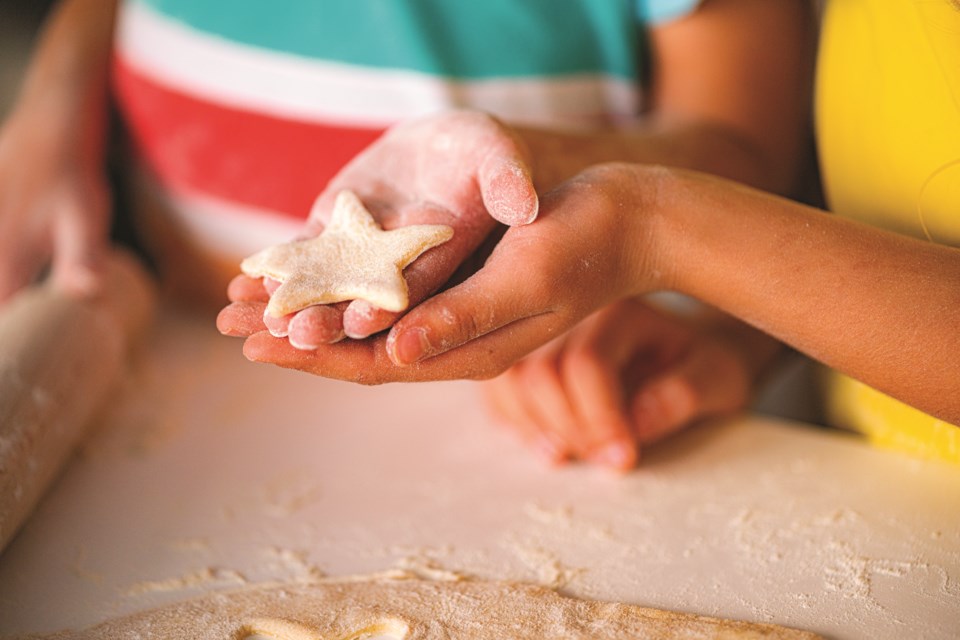It’s a winter wonderland up there on the mountains, luring snow buffs young and old out into that healthy mountain air.
Otherwise, if you’re pretty much stuck inside for these unique holly-daze, when normally you’d be out and about making the rounds —with family, friends, workmates, buddies, you name it (maybe even getting “baked” in the latest sense of the word)—take comfort: You’re just like millions of others on the planet right now, with mountains of time on our hands.
So whaddaya do when life gives you time? Bake, bake, bake.
Most of us, at least those of us working, seldom took the time to bake homemade goodies until the pandemic hit. But now, it’s a baking bonanza! There’s Twitter a-glitter with #baking featuring recipes galore for everything from ginger cookies to biscuits (there’s even some “baking shaming” going on, if you can believe it!). The “Baking” subreddit features things like a cute reindeer macaron, complete with mask since the maker messed up its mouth. Even a pandemic-conscious New York Times features 20 easy sweet treats, ready in one hour or less.
And that’s where my heart lies. Easy, yummy, ready in an hour.
“We do have all this time on our hands,” says my mom, who just whipped up a batch of her delectable shortbread, which my dad ate so much of one Christmas he actually got sick! She also made Chinese Chews, which her mom made since the 1930s, and a pan of brownies covered in yummy icing. After all, it’s the holidays, right? Icing? Bring it on!
Probably the biggest Canadian Christmas baked classics over the years were shortbread, mince tarts and Christmas cake. But as a kid I always went for those Chinese Chews, maybe because nan’s were shaped like balls, and what kid can resist balls?
So here’s my holiday gift to you: Our nan’s Chinese Chews recipe that’s nearly 100 years old. It’s fun to make and bake, especially if you’ve got young'uns around.
We have no idea where the name “Chinese Chews” came from, and we aren’t the only ones. It’s a common, catch-all name for a variety of simple recipes generations have used way beyond our family. Some speculate it could be due to the dates and other “exotic” ingredients like pecans added to the otherwise simple ingredients you’d typically find on a plain, farm-kitchen shelf or during rationing.
One Chinese Chews recipe I found online was from the Westinghouse Health-for-Victory recipe book published during the Second World War, when governments restricted domestic food supplies to “feed the war effort.” Old Canadian classics, like the Blue Ribbon Cook Book, first published in 1905, and cookbooks from Alberta’s famed “Blue Flame” natural gas kitchen, also feature Chinese Chews recipes, especially those from the Dirty Thirties — the Depression Years, when “thrift” was key.
Mom wonders if the name came from the mixture of “chopped” ingredients, since the turn-of-last-century Chinese cafes that dotted tiny towns across Canada wherever the rail lines ran—including Wimborne, Alta, (current population: 20, living in 14 houses), where she partially grew up—mostly served mixtures of chopped ingredients in sauces on top of rice.
It could also be a case of simple onomatopoeia—the lovely way the two “ch” sounds roll off your tongue.
Today, you can find dozens of Chinese Chews recipes online, but none I saw makes balls. One uses nothing but crispy chow mein noodles with chocolate and butterscotch chips you sprinkle overtop and melt in the microwave. I bet they’re good, but I also bet they aren’t really chewy.
But this recipe is. The secret is those balls. When you take them out of the oven, you cut them into squares and roll them into balls when they’re as warm as possible so they don’t get crusty. Be careful you don’t burn your hands, of course, especially when working with little ones. You can also simply cut them into squares and serve them. Or what the heck—just squish them into some weird shapes. But if you roll them into little balls before they cool, they’ll be at their chewiest best.
We call them nan’s unusual Chinese Chews, because they are. Perfect for holiday giving, since “balls” and “Christmas” go hand in glove, or is that mitten? Plus they’re durable so they’re easy to share, safely of course—you don’t need a plate or box.
Have fun. Enjoy! And stay merry and safe this unusual holiday season.
Nan’s Unusual Chinese Chews
Pre-heat oven to 350 F.
Beat well: 2 eggs and 1 c. white sugar (we cut the sugar back to 2/3 C.). Add 3 tbsp. melted butter. Combine.
Add: 1 C. chopped dates (press them down in the cup). 3/4 C. chopped walnuts or almonds (almonds taste better with the ginger, if you use it). 1/4 C. dried cherries and 1/4 C. dried pineapple (if these are hard to find, use 1/2 C. of deluxe fruit mix, which comes in a small round plastic container and has candied citrus peel; or 1/2 C. chopped candied cherries; all found in the baking department). 3-4 tbsp. finely chopped fresh ginger (optional). Mix.
In a separate bowl, add 1 tsp. baking powder and 2/3 tsp. salt to 3/4 C. flour. Mix well. Add to the egg/fruit mixture. Combine everything thoroughly.
Turn into a well-greased 8-inch square pan. Bake for 30-40 minutes or until a toothpick inserted in the middle comes out clean. Don’t dry it out. Cut into 3/4-inch squares and roll into balls when warm, as noted above. Do the outer edges first. If your hands get hot, just drop the balls onto the counter and squeeze them tight later. You can roll them in sugar, too, for a snowy effect.
Glenda Bartosh is an award-winning journalist who actually stopped and made Chinese Chews last Christmas.




